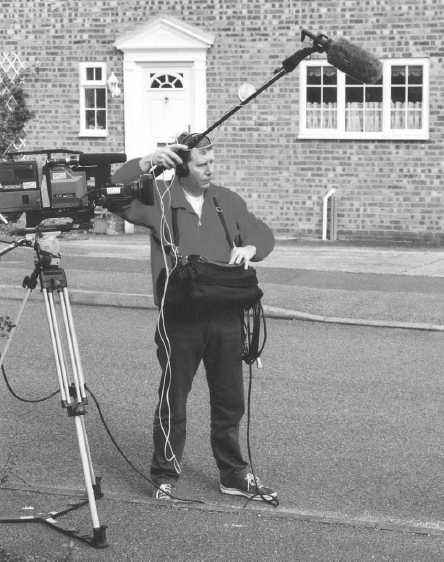27 Sound recordist operation: pole operation
Working with a gun mic on a fish pole (Figure 27.1(a),(b)) is an extremely flexible method of operation, and often the quickest means of placing the mic in the desired position. However, as mentioned earlier, assistance is not always available/affordable as and when you like, so as well as operating the mixer, you'll have to be able to manoeuvre the pole at the same time. Depending on circumstances, you can either work with one hand on the mixer and the other hand holding the pole with one end tucked under you arm, or wedged against your body; or you can hold the pole with both hands.

Figure 27.1 (a) Sound recordist holding the gun mic on a pole

Figure 27.1 (b) Gun mic on a pole
Using both hands is not as strange as you may think, and if you're operating on a windy exterior, with the pole at its full extension carrying a gun mic in its cradle and wind gag, then you'll need both hands to control it! Set an acceptable level on the mixer and vary the position of the mic to accommodate changes in level from your subject. Thus, if a person raises their voice, you have a choice of either using the channel fader on the mixer, or backing the mic off a few inches, depending on circumstances (and hands!). A combination of these two operations will help you maintain control over the relationship between the levels of speech and ambient sound.
However, with regard to ambient sound, be careful to keep the mic in the same plane when poling between contributors. This normally means keeping the mic vertical (Figure 27.2) and swinging the pole in a horizontal arc between the contributor and the reporter, since if you swivel the mic by rotating the pole on its axis, as opposed to moving it through space, you alter its acceptance/rejection relationship (angle) to the background, and the intensity of the background sound alters. Thus, the listener hears a change in the background noise level each time the mic re-positions during the dialogue, and/or the dubbing editor finds an edit difficult or impossible to conceal.
Add-ons
There's always an add-on you can get to help you out of sticky situations, and for pole operation, there are a couple that may make your life easier in the circumstances outlined above. Depending on the ‘reach’ necessary for the shot, you may like to use a body ‘harness’ that lets you steady the pole in a ‘stirrup’. Thus, you wear both the mixer and the stirrup.

Figure 27.2 The gun mic is held vertically between interviewee and interviewer, and the pole is pivoted (swung) between the reporter and the contributor, ensuring the mic remains in the same (i.e. vertical) plane. In this way, the relationship between foreground dialogue and background sound is maintained
Providing your mixer has the facility, you could use a remote fader attached to the pole which controls the gain of a channel fader (usually channel one). In this way, you can leave the mixer (on the ground/table/trolley, etc.) and hold the pole whilst standing closer to the contributors, controlling the gain if necessary via the fader on the pole.
Choice of pole
Which one do you need? It's almost like asking which size of screwdriver should you buy, no single one covers all eventualities. They come in many weights and sizes, comprising two, three, four (and sometimes more) telescopic sections. They need to be sturdy and lightweight, and not transfer handling noise to the mic. However, using a bass cut of 4 dB often improves the mic input by lessening the handling noise.
Although you would normally wind the mic cable round the pole, taking care not to leave slack that might flap against it and cause noise, there are poles available which have a tail at the top, to connect to the mic, and an XLR socket in their base. Many modern poles are carbon fibre, often with felt, or similar fabric, covering the outer base tube, and these tend to be the lightest weight. They may be prone to sticking, however, and since they're also relatively expensive, many opt for a metal pole, when funds are limited.
Me and my shadow
The main curse of the pole is when it throws a shadow. That's what the cameraman says, of course the recordist knows it's the lighting that's caused the problem. Unfortunately, if the light happens to be coming from the sun, low in the sky, then it's not always practical to reposition the camera simply to eliminate the shadow, because ‘That's the shot!’ Or it may be lack of space on a location that forces the cameraman to place lights in positions which throw unwanted shadows the minute you put the pole in place. Under these circumstances there's usually no choice but to revert to the ubiquitous clip mics.
